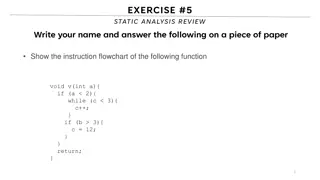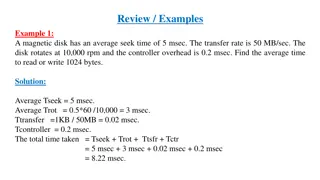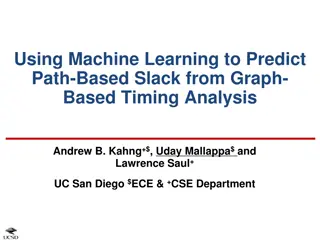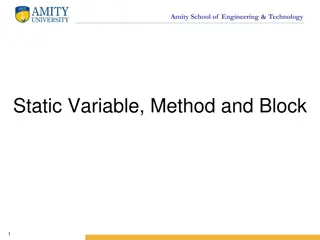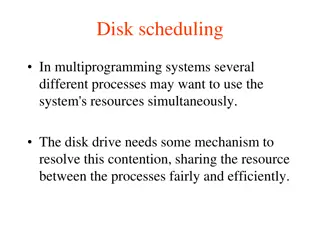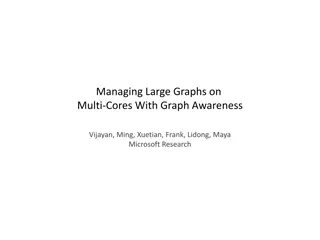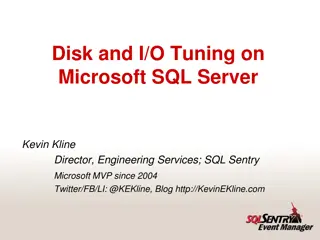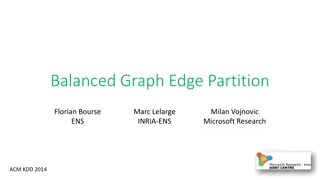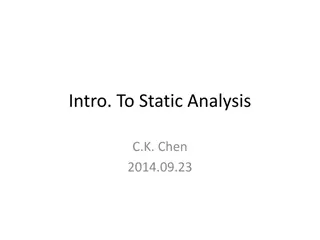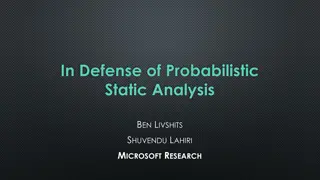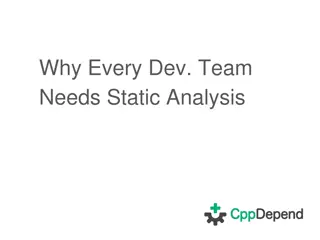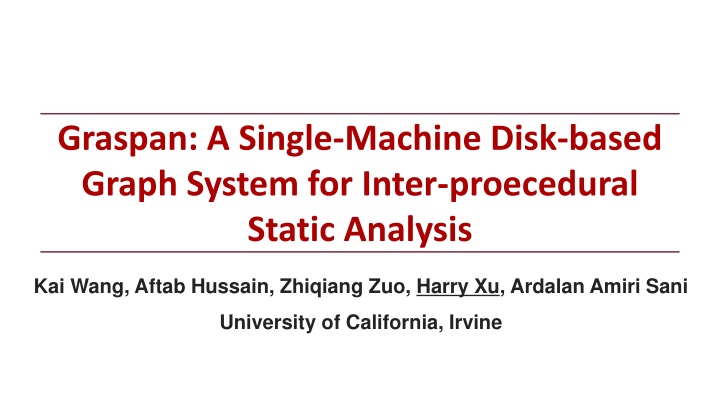
Disk-based Graph System for Static Analysis
A comprehensive exploration of a single-machine disk-based graph system, Graspan, designed for inter-procedural static analysis in various applications such as machine learning, information retrieval, and bioinformatics. The system addresses big data challenges in static analysis, offering solutions for context-sensitive analysis in large codebases, server applications, and data-intensive systems.
Download Presentation

Please find below an Image/Link to download the presentation.
The content on the website is provided AS IS for your information and personal use only. It may not be sold, licensed, or shared on other websites without obtaining consent from the author. If you encounter any issues during the download, it is possible that the publisher has removed the file from their server.
You are allowed to download the files provided on this website for personal or commercial use, subject to the condition that they are used lawfully. All files are the property of their respective owners.
The content on the website is provided AS IS for your information and personal use only. It may not be sold, licensed, or shared on other websites without obtaining consent from the author.
E N D
Presentation Transcript
Graspan: A Single-Machine Disk-based Graph System for Inter-proecedural Static Analysis Kai Wang, Aftab Hussain, Zhiqiang Zuo, Harry Xu, Ardalan Amiri Sani University of California, Irvine
GraphChi Graph Datasets GridGraph Graph Systems 2
Intimacy Between Systems and App. Areas Machine Learning Information Retrieval Bioinformatics Systems 3
Where Is PLs Position in Big Data? -- Another Source of Big Data SAT Solver, Program Analysis, Model Checking, PL Problems Existing Work System Solutions Our Work Big Data Systems Scalable Results 4
Treating Static Analysis as Big Data Problem An important PL problem: Context-sensitive static analysis of very large codebases Linux kernel Large server applications Distributed data-intensive systems Pointer/alias analysis Dataflow analysis May/must analysis 5
Context-Free Language (CFL) Reachability A program graph P K l2 l1 a b c c is K-reachable from a A context-free Grammar G with balanced parentheses properties K l1 l2 6 Reps, Program analysis via graph reachability, IST, 1998
A Wide Range of Applications Pointer/alias analysis Alias b = a; c = b; a b c Assign Assign Alias Assign+ Dataflow analysis, pushdown systems, set-constraint problems can all be converted to context-free-language reachability problems 7 Sridharan and Bodik, Refinement-based context-sensitive pointsto analysis for Java, PLDI, 2006 Zheng and Rugina, Demand-driven alias analysis for C, POPL, 2008
A Wide Range of Applications (Cont.) Pointer/alias analysis Alias b = & a; // Address-of c = b; d = *c; // Dereference a b c d & Alias * Alias Assign+ | & Alias * Address-of & / dereference* are the open/close parentheses 8 Sridharan and Bodik, Refinement-based context-sensitive pointsto analysis for Java, PLDI, 2006 Zheng and Rugina, Demand-driven alias analysis for C, POPL, 2008
A Dynamic Transitive Closure Problem Traditional Approach: a worklist-based algorithm the worklist contains reachable vertices no transitive edges are added physically Problem: embarrassingly sequential and unscalable 9
No Worry About Memory Blowup As long as one knows how to use disks and clusters Big Data thinking: Solution = (1) Large Dataset + (2) Simple Computation + System Design 10
Turning Big Code Analysis into Big Data Analytics Key insights: Adding transitive edges explicitly satisfying (1) Core computation is adding edges satisfying (2) Leveraging disk support for memory blowup Can existing graph systems be directly used? No, none of them support dynamic addition of a lot of edges 11
Graspan: A Graph System for Interprocedural Static Analysis of Large Programs Scalable Disk-based processing on the developer's work machine Parallel Edge-pair centric computation Easy to implement a static analysis Developer only needs to generate graphs in mechanical ways and provide a context-free grammar to implement the analysis 4 students + 1 postdoc, 1.5 years of development; implemented in both Java and C++ https://github.com/Graspan/ 12
How It Works? G GRAMMAR RULES 13
Granspan Design Partitions are of similar sizes Each partition contains an adjacency list of edges Edges in each partition are sorted Edge-Pair Centric Computation Preprocessing Post-Processing 14
Computation Occurs in Supersteps Edge-Pair Centric Computation Preprocessing Post-Processing 15
Each Superstep Loads Two Partitions 0 C 1 A B 1 0 2 2 3 4 Edge-Pair Centric Computation Preprocessing Post-Processing 16
Each Superstep Loads Two Partitions 0 1 2 3 4 We keep iterating until delta is 0 Edge-Pair Centric Computation Preprocessing Post-Processing 17
Post-Processing Repartition oversized partitions to maintain balanced load on memory Save partitions to disk Scheduler favors in-memory partitions and those with higher matching degrees Edge-Pair Centric Computation Preprocessing Post-Processing 18
What We Have Analyzed Program Linux 4.4.0-rc5 PostgreSQL 8.3.9 Apache httpd 2.2.18 #LOC 16M 700K 300K #Inlines 31.7M 290K 58K With A fully context-sensitive pointer/alias analysis A fully context-sensitive dataflow analysis On a Dell Desktop Computer with 8GB memory and 1TB SSD 19
Evaluation Questions and Answers Can the interprocedural analyses improve D. Englers checkers? Found 85 new bugs in Linux 4.4.0-rc5 Is Graspan efficient and scalable? Computations took 11 mins 12 hrs How easy to use Graspan? 1K LOC of C++ for writing each of points-to and dataflow graph generators Provide a grammar file Graspan v/s other engines? GraphChi crashed in 133 secs LogicBlox and SocialLite ran out of memory for all our programs Traditional analysis implementation ran 3 days for the smallest graph 20
Conclusion 4 students + 1 postdoc, 1.5 years of development; Implemented in both Java and C++ https://github.com/Graspan/ 21


